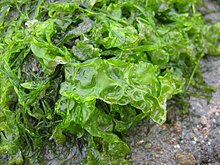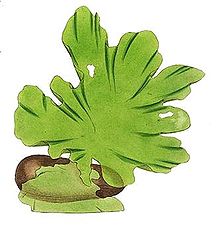| Ulva lactuca | |
|---|---|
 | |
| Scientific classification | |
| Domain: | Eukaryota |
| Kingdom: | Plantae |
| Phylum: | Chlorophyta |
| Class: | Ulvophyceae |
| Order: | Ulvales |
| Family: | Ulvaceae |
| Genus: | Ulva |
| Species: | U. lactuca |
| Binomial name | |
| Ulva lactuca Linnaeus, 1753 | |
Contents
|
Description
Ulva lactuca is a thin flat green alga growing from a discoid holdfast. The margin is somewhat ruffled and often torn. It may reach 18 cm or more in length, though generally much less, and up to 30 cm across.[1] The membrane is two cells thick, soft and translucent,[2] and grows attached, without a stipe, to rock by a small disc-shaped holdfast.[3] Green to dark green in color, this species in the Chlorophyta is formed of two layers of cells irregularly arranged, as seen in cross section. The chloroplast is cup-shaped with 1 to 3 pyrenoids. There are other species of Ulva which are similar and not always easy to differentiate.Distribution
The distribution is worldwide: Europe, North America (west and east coasts), Central America, Caribbean Islands, South America, Africa, Indian Ocean Islands, South-west Asia, China, Pacific Islands, Australia[1] and New Zealand.[2] [4]Ecology
Ulva lactuca is very common on rocks and on other algae in the littoral and sublittoral on shores all around the British Isles,[5] the coast of France,[6] the Low Countries[6] and up to Denmark.[7] It is particularly prolific in areas where nutrients are abundant.[8] This has been the case off the coast of Brittany where a high level of nitrates, from the intensive farming there, washes out to sea.[9][10] The result is that large quantities of Ulva lactuca are washed up on beaches, where their decay produces methane, hydrogen sulphide, and other gases.[9][11]Certain environmental conditions can lead to the algae spreading over large areas. In August 2009, unprecedented levels of the algae washed up on the beaches of Brittany, France,[12][13] causing a major public health scare as it decomposed. The rotting thalli produced large quantities of hydrogen sulphide, a toxic gas. In one incident near Saint-Michel-en-Grève, a horse rider lost consciousness and his horse died after breathing the seaweed fumes. Environmentalists blamed the phenomenon on excessive use fertilizers and the excretion of nitrates by pig and poultry farmers.[12] In a separate incident at the same beach, a truck driver and several schoolchildren died after taking part in the cleanup without protection.[citation needed]


No comments:
Post a Comment